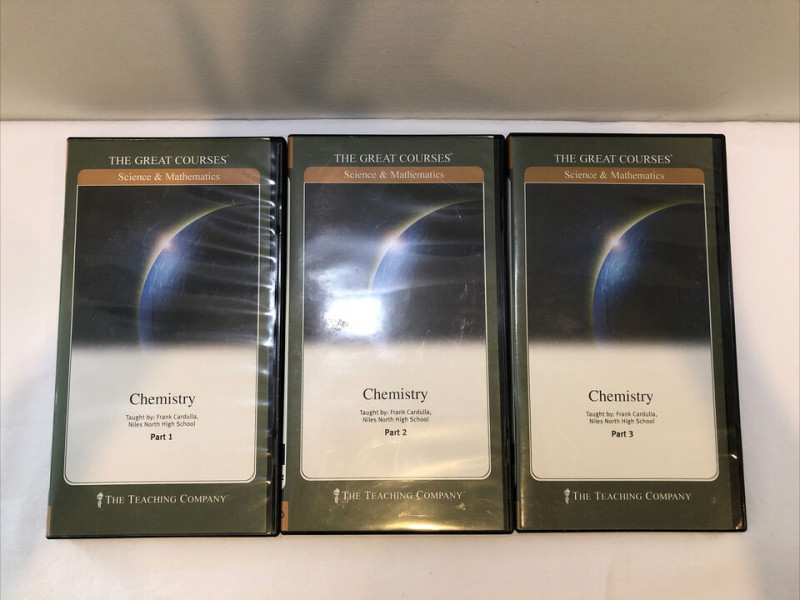
High School Level Chemistry
English | 1994 | 14 hrs and 54 mins | MP3 | 205 MB
Worst Subject?
Chemistry teachers will tell you that there is an experience they have all had many times. Someone will ask them, "What do you do for a living?" and when they reply, "I'm a chemistry teacher," the all-too-common response is:
"That was my worst subject!"
Why is that? Is high school chemistry just so intrinsically difficult that only students with great intellectual gifts are capable of succeeding without heroic efforts?
"The Easiest Class in School"
Frank Cardulla doesn't believe that for a moment, and he will hopefully convince you, as he has thousands of high school students, that "chemistry is the easiest class in school."
Students often claim it is the "math" that is difficult. But high school chemistry normally only demands that students be able to add, subtract, multiply, and divide numbers and do some simple algebra. Calculators take care of the first four, and most students can handle the latter.
It's not the "math" that some students find difficult. It's the requirement to engage in what might be called "quantitative reasoning" the ability to take the numbers presented in what are often called "word" or "story" problems and put them together in the proper way to arrive at the correct answer. Should the numbers be multiplied or divided? And if divided, how do you know which number to put in the numerator and which in the denominator?
This difficulty is far and away what "turns off" many students to chemistry, and it is addressing this difficulty that is the focus of these chemistry lectures.
The Hardest Parts Have Simple Answers
As Mr. Cardulla puts it, "My goal in these lectures is not to quickly cover every topic that is typically included in most high school chemistry courses. Most students don't need a lot of help learning element symbols or memorizing definitions. With reasonable effort they can learn the basic structure of atoms and how the Periodic Table works. That isn't the stumbling block. It's quantitative reasoning solving those 'story' problems. It's the mole concept and its application to stoichiometry and molarity and equilibrium. This is what frustrates so many, because they think solving these kinds of problems requires either some exceptional intellect or some kind of 'special' approach totally divorced from the kind of quantitative reasoning we all use naturally and often effortlessly in everyday life. It doesn't."
He justifies this statement by showing how "chemical" reasoning is nothing more than an extension of the kind of quantitative reasoning that most of us use every day. Once this base is firmly established, this simple, natural reasoning is then applied to most of the important problem-solving situations that face high school chemistry students, from density, to the mole, to molarity, stoichiometry, and equilibrium.
Genuine Understanding That Lasts
Cardulla refuses to have students learn mathematical "gimmicks" that allow them to obtain correct answers to simple problems without any real understanding, only to have them fall apart later when problems are encountered that demand understanding.
Instead, he establishes a firm foundation a foundation based on a real and deep understanding of basic concepts and how one can apply the kind of simple, natural quantitative reasoning we all use every day to what are truly simple chemistry problems once this basic understanding is established. It is this basis of true understanding that makes chemistry "the easiest class in school."
Mr. Cardulla has published articles and given numerous presentations about this simple, logical approach, and the achievements of his students bear testimony to its effectiveness. He has received citations from institutions such as MIT and the University of Chicago for being named "most influential teacher" by attending students.
He is the recipient of numerous teaching awards. Included are the Davidson Award, a Presidential Award for Science Teaching, the National Catalyst Award for Outstanding Chemistry Teaching, and the National James Bryant Conant Award. The latter two are given to only one high school chemistry teacher in the entire United States each year.
Throughout this tutorial, Mr. Cardulla uses, in equal measure, the blackboard, a flipchart on an easel, and computer-generated graphic screens to illustrate his lessons, which also include about a dozen physical demonstrations.
Available on DVD and Videotape
Due to the highly visual nature of its subject matter, this course is available only on videotape and DVD.
High School Level Chemistry
(30 lectures, 30 minutes/lecture)
Course No. 111
Taught by Frank Cardulla
Retired, Niles North High School, Chicago, Illinois
M.S., University of Illinois
Course Lecture Titles
Introduction and Philosophy
Quantitative Reasoning in Life and Chemistry (Part I)
Quantitative Reasoning in Life and Chemistry (Part II)
Density
The SI (Metric) System of Measurement
Converting between Systems of Measurement
The Mole Concept: Preliminary Ideas
The Mole
Solving Mole Problems
Avogadro's Hypothesis and Molar Volume
Percent Composition and Empirical Formulas
Solving Empirical Formula Problems
Writing and Balancing Chemical Equations
An Introduction to Stoichiometry
Stoichiometry Problems
Advanced Stoichiometry
An Introduction to Molarity
Solving Molarity Problems
Additional Molarity Problems
Basic Concepts of Chemical Equilibrium (Part I)
Basic Concepts of Equilibrium (Part II)
Interpreting an Equilibrium Constant
Le Chatelier's Principle (Part I)
Le Chatelier's Principle (Part II)
An Introduction to Equilibrium Problems
The Self-Ionization of Water
Strong Acids and Bases (Part I)
Strong Acids and Bases (Part II)
Weak Acids and Bases
Solubility Equilibria






